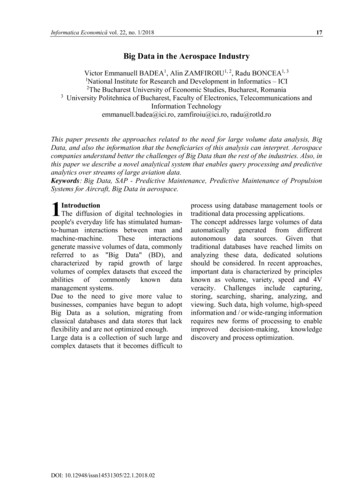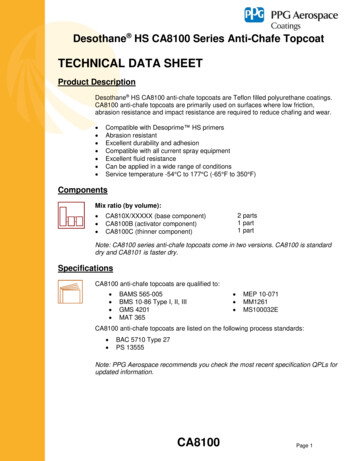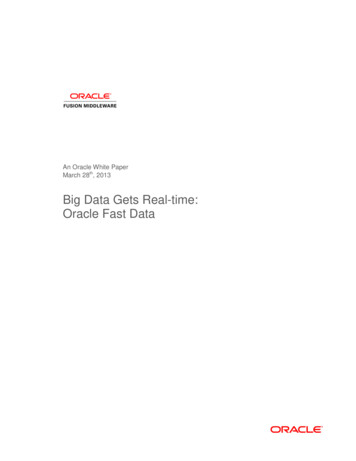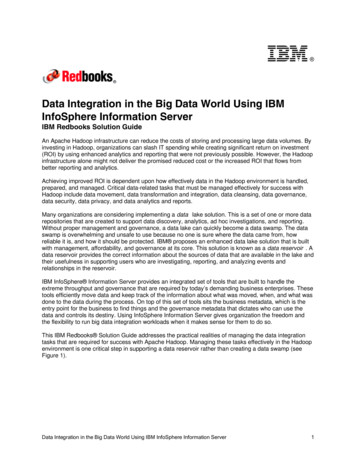
Transcription
Informatica Economică vol. 22, no. 1/201817Big Data in the Aerospace Industry3Victor Emmanuell BADEA1, Alin ZAMFIROIU1, 2, Radu BONCEA1, 31National Institute for Research and Development in Informatics – ICI2The Bucharest University of Economic Studies, Bucharest, RomaniaUniversity Politehnica of Bucharest, Faculty of Electronics, Telecommunications andInformation Technologyemmanuell.badea@ici.ro, zamfiroiu@ici.ro, radu@rotld.roThis paper presents the approaches related to the need for large volume data analysis, BigData, and also the information that the beneficiaries of this analysis can interpret. Aerospacecompanies understand better the challenges of Big Data than the rest of the industries. Also, inthis paper we describe a novel analytical system that enables query processing and predictiveanalytics over streams of large aviation data.Keywords: Big Data, SAP - Predictive Maintenance, Predictive Maintenance of PropulsionSystems for Aircraft, Big Data in aerospace.1IntroductionThe diffusion of digital technologies inpeople's everyday life has stimulated humanto-human interactions between man andmachine-machine.Theseinteractionsgenerate massive volumes of data, commonlyreferred to as "Big Data" (BD), andcharacterized by rapid growth of largevolumes of complex datasets that exceed theabilities of commonly known datamanagement systems.Due to the need to give more value tobusinesses, companies have begun to adoptBig Data as a solution, migrating fromclassical databases and data stores that lackflexibility and are not optimized enough.Large data is a collection of such large andcomplex datasets that it becomes difficult toDOI: 10.12948/issn14531305/22.1.2018.02process using database management tools ortraditional data processing applications.The concept addresses large volumes of dataautomatically generated from differentautonomous data sources. Given thattraditional databases have reached limits onanalyzing these data, dedicated solutionsshould be considered. In recent approaches,important data is characterized by principlesknown as volume, variety, speed and 4Vveracity. Challenges include capturing,storing, searching, sharing, analyzing, andviewing. Such data, high volume, high-speedinformation and / or wide-ranging informationrequires new forms of processing to enableimproveddecision-making,knowledgediscovery and process optimization.
18Informatica Economică vol. 22, no. 4/2018Fig. 1. Big Data int IoTThe IoT implies that data is collected fromseveral types of sources in constrainedenvironments. Large-scale data generated inthe IoT offers as an immediate promise realtime responses and predictions andpersonalized options.2 Aerospace IndustryBig Data represents a new generation oftechnologies and architectures designed toextract value from the huge data volumes witha large variety, allowing processingand analysis in real time. [1]Aerospace companies understand better thechallenges of Big Data than the rest of theindustries.A clear example of the impact of Big Data inthe aerospace industry is the "digital aircraft"from our days, which can collect up to300,000 parameters, depending on theduration of the flight and the type ofaircraft. A major aircraft manufacturerestimates that data transmission will increaseby 14 % over the next few years.A simple and practical example could be thefollowing: An average Boeing 737, twoengine commercial aircraft, takes a six-hourflight between New York and LosAngeles. Each engine generates 20 terabytesof information per hour. By multiplying 20terabytes of information from a single enginewith a 6 hour flight, we will get 240 terabytesof data from the engines. According to theNational Association of Air TrafficControllers in the United States, a total of87,000 are crossing the sky of the UnitedStates of America, of which are 29,000commercial flights. By multiplying this by365 days, we will get a real challenge, but alsoa simplification in terms of Big Data service.[2]DOI: 10.12948/issn14531305/22.1.2018.02
Informatica Economică vol. 22, no. 1/201819Fig. 2. Sensors data from a cross-country flight [2]To better understand the magnitude of thisamount of data, we will make the followingcomparison: the number of ten digitsrepresented in the Figure 2 in TB, mentionedabove, is converted to 2.7 ZB. This 2.7 ZB isalmost equal to the total global traffic dataestimated in 2015. [2]The analysis of this information results in thefollowing questions: Whyanaircraftmanufacturer/commercial airline operator would liketo receive all the data collected andstored? What would be the impact if thisinformation were not used?The answer would be very simple: an aircraftmanufacturer /airlineoperator wouldnormally use this data to maximizeoperational efficiency, and the impact of notusing this information would particularlyaffect the company's operations, aircraftproduction, maintenance and managementcompany for the level of the air fleet.When an airline buys a 100-390 million dollaraircraft for its fleet, the goal is to keep theairplane in service for at least 18 hours a dayfor the next 15 to 20 years. At the heart of thiseffort is an airline maintenance organizationthat aims to manage routine and non-routineissues to keep the fleet up and running.Based on an analysis of the International AirTransport Association (IATA), the main causeof42%flightdelaysisbasedon airline processes such as maintenance. Forevery hour when the aircraft is out of service,the commercial air operator loses an averageof 10,000. [2]Fig. 3. Why Airlines need to keep planes in the air [2]Predictive analysis can help convert hugeamounts of relevant maintenance dataDOI: 10.12948/issn14531305/22.1.2018.02(whether from sensors or logistics informationfrom ERP systems - Enterprise Resource
20Planning) into information that can be takento ensure that maintenance techniciansperform the steps match at the right time andwith the right tools. The anticipative analysiscan contribute to strategic improvement andalso to delivering better quality productionwith lower operating costs and increase theinvestment.3 The need to analyze high volume dataBeneficiaries of high-volume data analysis arerepresented by: air traffic controllers, airlines,aircraftmanufacturers,etc. With dataprovided by aircraft, on flight or on theground, the beneficiaries can optimize theiroperational efficiency, improving thecompany's operations, aircraft production,timely maintenance planning, etc. Examplesof efficient use / analysis of high volume data: congestion of air traffic can be reduced; passengers may be informed abouttimetables and flight operations on theirway to the airport; air traffic delays can be reduced; scheduled maintenance work, avoidingadditional costs.These are just a few things that would simplifythe flights or company activities. However,airlines and airports still have limitedcapabilities to process / implement thisvaluable information quality and to useadvanced systems to analyze large volumedata in order to optimize information.All of these beneficiaries must provide aircraftfor the pilots in perfect working order to meetin good flight conditions. Although theanalysis of large volume data is complex andworking conditions are not always the mostfavorable, the satisfaction of maintaining themaximum operational capacity of aircraft isvery high.There are, however, a lot of airlinemaintenance organizations where large dataanalysis, Big Data, is not being implemented,Informatica Economică vol. 22, no. 4/2018all based on a production plan on the basis ofwhich, at the beginning of the year, there isjust a need for spare parts and material, butwhich is not entirely secured. Unpredictablemalfunctions occur during the year, they aremore difficult to repair due to shortages and,following reports of necessity, technicianshave to take the from other aircraft, whichleads to the delay in finalizing the works,doubling the effort of the technical staff, thusinvolving additional costs.Currently, an aircraft that performs a flight,has its own flight plan (a series of points overwhich it will pass to reach the destination). Inthe vast majority of cases, it does not happenas the flight is planned because there are anumber of events that lead to this conclusion,such as: the airline has shifted the departure timefor an aircraft, for various reasons; a meteorological event forbids any aircraftto pass through a certain area; a traffic controller gives the pilotpermission to use a "shortcut".The use of high volume data analysis for thebenefit of air traffic control can be used tomanage air traffic safely, create more efficientflight routes, and exchange information withairlines to improve performance and flightsafety.4 Case studies using Big Data4.1 Real-time aircraft monitoring using theBigDataplatformSAPPredictive MaintenanceMaintenance is the repair, inspection ormodification of an aircraft or itscomponent. Aircraft maintenance is regulatedto ensure safe and correct flight operation oftheaircraft. Nationalregulationsarecoordinated in line with internationalstandards, maintained by bodies such as theInternational Civil Aviation Organization(ICAO).DOI: 10.12948/issn14531305/22.1.2018.02
Informatica Economică vol. 22, no. 1/201821Fig. 4. SAP Predictive Maintenance [3]Predictive Maintenance Technique isdesigned to help determine the loss of anaircraft equipment and to predict whenmaintenance is to be done.The key to predictive maintenance is "correctinformation at the right time"In the above Figure 4, with the help of the SAPPredictive Maintenance program, the BigData from an aircraft in flight is analyzed inreal time.Figure 4 gives us the following information:the aircraft have to make in October thescheduled maintenance for the enginecompressor, also we can see that the repairtime is 6 hours, and the replacement part is instock. As unscheduled maintenance, theairplane has to replace an engine electricalcomponent - EEC, the repair time is 4 hours,but the piece is not yet in stock. As well asunscheduled maintenance, the aircraft has toperform the necessary maintenance after5,000 hours of flight, this operation can beseen it will take an hour.4.2. Real-time monitoring of aircraftpropulsion systems (engines)Air transport is necessary for modernlife. Maintenance of aircraft propulsionsystems is costly, requiring a very carefulapproach.Propulsion systems are equipped withsensors that monitor the engine's operatingconditions during the flight. In the figurebelow are a few sensors that fit an aircraftengine.Fig. 5. Simplified view of some of the sensors [4]DOI: 10.12948/issn14531305/22.1.2018.02
22Informatica Economică vol. 22, no. 4/2018By combining data from these Big DataSensors with advanced analyzes, it is possibleto monitor the behavior of propulsion systemsin real time, so that we can predict theremaining useful life of a componentbelonging to the engine so we can schedulemaintenance in a timely manner to avoidunnecessary mechanical malfunctions, butalso a very high cost generated by defectivemaintenance.This monitoring system includes data entry,data storage, data processing and analysis, allof this are essential for creating a predictivemaintenance solution.Although this example is customized foraircraft engine monitoring, the solution can beeasily generalized for other predictivemaintenance scenarios such as landing gear,structural integrity of the aircraft, etc.By reducing downtime and ensuring effectiveengine performance, this solution allows theaircraft fleet to remain operational in the mostcost effective way.If an aircraft is in flight, poor maintenance ofpropulsion systems can have very seriousconsequences. The best case may be to landthe aircraft after a failure in the propulsionsystem, in a safe condition, until themalfunction is remedied. This involvesproblems that can be particularly costly, giventhat the aircraft is in a location where there areno suitable technicians or spare parts.Fig. 6. Predictive maintenance of propulsion systems [5]Figure 6 is based on the following inputdata: both engines have a number of 4sensors, namely: temperature sensor, pressuresensor, noise level sensor, vibration levelsensor. The analysis is performed todetermine the remaining useful life of theengines that fit this aircraft. This analysisis based on a number of 65 cycles perengine. The higher the number of cycles, thegreater the efficiency of the dataprovided. Followingthispredictivemaintenance analysis of propulsion systemsbased on high volume data analysis, we drawthe following conclusions: By analyzing thedata from the four sensors, we can easily seethat the engine with no. 2 which equips thisaircraft, has a less useful life than the enginewith no. 1, 152 days versus 162 days. ThisDOI: 10.12948/issn14531305/22.1.2018.02
Informatica Economică vol. 22, no. 1/2018analysis is very useful for the maintenanceorganization's technicians, because they knowexactly when both engines must be out ofservice, so it can be timely scheduled themaintenance required to replace it, orreplacement of both engines, given that theremaining useful life for the two engines isnear, so that the aircraft is not immobilizedtwice for the same operation, resulting highefficiency and low cost.5 ConclusionsHigh volume data start to have a major impacton air travel. The opportunities to use thesedata will continue to grow in the future. Anairplane is more than just a classic car thattakes us from one city to another. Modernairplanes are data centers themselves. Theanalysis of high volume data for an airlinestarts from aircraft predictive maintenance,flight plans, weather conditions and up to thepurchase of tickets by future passengers. Foran airline or even an air traffic controller, theweather conditions are a key element inensuring a safe flight. So, combining twodifferent data sources (weather forecasts andflight plans), the users of the high volume dataanalysis can view in real time the place
A simple and practical example could be the following: An average Boeing 737, two-engine commercial aircraft, takes a six-hour flight between New York and Los Angeles. Each engine generates 20 terabytes of information per hour. By multiplying 20 terabytes of information from a single engine with a 6 hour flight, we will get 240 terabytes of data from the engines. According to the National .











